
"Mud in Mud, Rock in Rock" - The flesh and bone of Yixing Zisha purple clay

Zisha teapots are unique to Chinese tea culture. The clay is very special, only present in Yixing. Their process of crafting teapots is unique, different than anywhere else in the world. They also incorporate Chinese arts and literature, painting, calligraphy, carving, and other decorative techniques that are unique to Chinese culture and history.
So when did the name “Zisha”, as regards purple clay teapots, emerge as the name uniquely designated for Yixing Teapots? Well, as early as the Song dynasty more than 1000 years ago, the name Zisha appeared in the poetry and literature of intellectuals as referring to purple mud. During the Qing dynasty, most of the Yixing teapots were named as “Yang Xian Clay Pots” (阳羡砂壶), Yangxian was the ancient name for Yixing. Historically the potter masters had never had a defined term for Zisha clay, instead they named the clay in accordance with location where the clay was excavated, so there were many different names such as "green clay", "Di Cao Qing", purple mud, etc. Then in the 1990s, the name was designated by the contemporary great master Xu Xiu Tang (徐秀棠) in his book "Chinese Zisha", or Chinese Purple Clay in English. His book has gained wide recognition and credibility. He points out that Zisha is "mud in mud, rock in rock." Here the "mud" refers to the decayed or eroded rock that appears as mud but it is not like mud from anywhere else. The rock refers to quartz and other undecayed rocks.
Unlike any other clay in the world of pottery, purple clay has unique attributes that no other clay possesses. It is said that purple clay has the bone, which is the "sha", the actual quartz or crystal in the clay. The mud, which is like the flesh of clay, comes from the decay/erosion of the rock, not from an actual mud like other common pottery clays. Because of the decayed quartz in the clay, it is much more durable, withstanding very high firing conditions, which also forms tiny pores in the composition of the fired clay, giving it the unique attribute of breathability. It is this breathable attribute that allows the zisha teapots to preserve the essence of the tea that is brewed within.

Above picture, Victoria standing at the reserve #4 mining site of Yellow Dragon Mountain in the fall of 2018.
So what are the great attributes of Zisha clay?
- Zisha has very strong adhesion but not to human hands or the potters’ tools, which makes it ideal for hand crafting the teapot.
- The green body has strong bonding strength and density that make it helps facilitate the shaping of the mouth, lid, handle and spout according to the design.
- A single clay material can be used in crafting a teapot, no other materials or components are necessary.
- Breathable quality: Zisha has quartz that forms holes in the texture, or porous clay as some would say, which allows ventilation in and while still holding water. This allows tea leaves to stay in the teapot without affecting the flavor and prevents tea leaves from spoiling overnight.
- Zisha has the ability to sustain sudden cold and hot temperature changes. Cold teapots can withstand hot water, making it ideal for brewing tea.
- Zisha teapots have a smooth surface with a natural glow. After a period of use, the teapot becomes seasoned and exhibit a natural radiant glow.

Because of these unique wonderful attributes, Yixing clay teapots have gained a well-deserved growing reputation and are beloved by tea lovers around the world. Like any other natural resource, it has been in use for hundreds of years and has been extensively excavated during China's recent tea renaissance of recent decades, and like any natural resource, it will eventually be used up. In 2007 the governing Wuxi city authority passed a bylaw to prohibit the further excavation of purple clay from the Yellow Dragon Mountain located in the city of Yixing. That ruling restricted the supply of authentic zisha clay on the market, resulting in much elevated teapot prices for authentic high quality zisha clay. Traditionally, many potter masters have private reserve for supplying their pottery-crafting practice, some with huge deposits of authentic high quality purple clay that they can pass on to the next generation, so there has yet to be a significant shortage of good quality purple clay teapots on the market, though they are now sold at a much higher price. There are a lot of so-called “zisha” teapots on the market that are not authentic zisha clay, but are crafted from a formulated clay consisting of a little Zisha or some common clays or mud from other places, with added materials and components to create a zisha-like clay. Even worse are those who use commonly found mud and add different chemical components to mimic purple clay. As a Yixing teapot lover, one should be aware of these issues and use sound discerning judgement, especially if you wish to enjoy the wonderful benefits of a true zisha teapot.

Nothankyou on
Sounds like more marketing blah blah